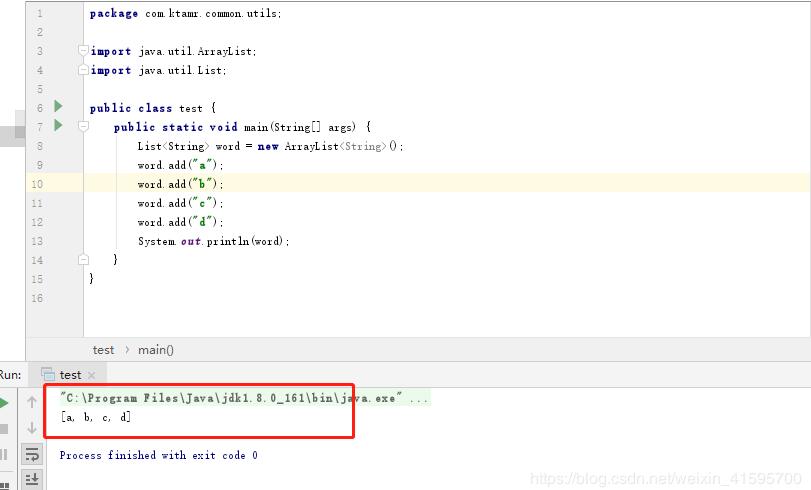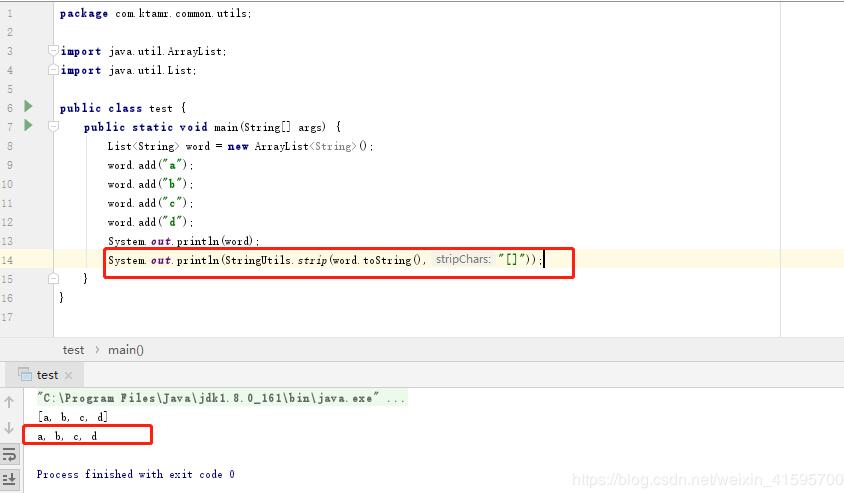Java List集合返回值去掉中括号('[ ]')的操作
如下所示:

调用StringUtils工具类的strip()方法去掉中括号'[ ]':
StringUtils.strip(word.toString(),'[]') //第一个参数放集合,第二个参数去掉中括号'[]'
StringUtils工具类代码:

package com.ktamr.common.utils; import com.ktamr.common.core.text.StrFormatter; import java.util.Collection;import java.util.Map; /** * 字符串工具类 * * @author ktamr */public class StringUtils extends org.apache.commons.lang3.StringUtils{ /** 空字符串 */ private static final String NULLSTR = ''; /** 下划线 */ private static final char SEPARATOR = ’_’; /** * 获取参数不为空值 * * @param value defaultValue 要判断的value * @return value 返回值 */ public static <T> T nvl(T value, T defaultValue) { return value != null ? value : defaultValue; } /** * * 判断一个Collection是否为空, 包含List,Set,Queue * * @param coll 要判断的Collection * @return true:为空 false:非空 */ public static boolean isEmpty(Collection<?> coll) { return isNull(coll) || coll.isEmpty(); } /** * * 判断一个Collection是否非空,包含List,Set,Queue * * @param coll 要判断的Collection * @return true:非空 false:空 */ public static boolean isNotEmpty(Collection<?> coll) { return !isEmpty(coll); } /** * * 判断一个对象数组是否为空 * * @param objects 要判断的对象数组 ** @return true:为空 false:非空 */ public static boolean isEmpty(Object[] objects) { return isNull(objects) || (objects.length == 0); } /** * * 判断一个对象数组是否非空 * * @param objects 要判断的对象数组 * @return true:非空 false:空 */ public static boolean isNotEmpty(Object[] objects) { return !isEmpty(objects); } /** * * 判断一个Map是否为空 * * @param map 要判断的Map * @return true:为空 false:非空 */ public static boolean isEmpty(Map<?, ?> map) { return isNull(map) || map.isEmpty(); } /** * * 判断一个Map是否为空 * * @param map 要判断的Map * @return true:非空 false:空 */ public static boolean isNotEmpty(Map<?, ?> map) { return !isEmpty(map); } /** * * 判断一个字符串是否为空串 * * @param str String * @return true:为空 false:非空 */ public static boolean isEmpty(String str) { return isNull(str) || NULLSTR.equals(str.trim()); } /** * * 判断一个字符串是否为非空串 * * @param str String * @return true:非空串 false:空串 */ public static boolean isNotEmpty(String str) { return !isEmpty(str); } /** * * 判断一个对象是否为空 * * @param object Object * @return true:为空 false:非空 */ public static boolean isNull(Object object) { return object == null; } /** * * 判断一个对象是否非空 * * @param object Object * @return true:非空 false:空 */ public static boolean isNotNull(Object object) { return !isNull(object); } /** * * 判断一个对象是否是数组类型(Java基本型别的数组) * * @param object 对象 * @return true:是数组 false:不是数组 */ public static boolean isArray(Object object) { return isNotNull(object) && object.getClass().isArray(); } /** * 去空格 */ public static String trim(String str) { return (str == null ? '' : str.trim()); } /** * 截取字符串 * * @param str 字符串 * @param start 开始 * @return 结果 */ public static String substring(final String str, int start) { if (str == null) { return NULLSTR; } if (start < 0) { start = str.length() + start; } if (start < 0) { start = 0; } if (start > str.length()) { return NULLSTR; } return str.substring(start); } /** * 截取字符串 * * @param str 字符串 * @param start 开始 * @param end 结束 * @return 结果 */ public static String substring(final String str, int start, int end) { if (str == null) { return NULLSTR; } if (end < 0) { end = str.length() + end; } if (start < 0) { start = str.length() + start; } if (end > str.length()) { end = str.length(); } if (start > end) { return NULLSTR; } if (start < 0) { start = 0; } if (end < 0) { end = 0; } return str.substring(start, end); } /** * 格式化文本, {} 表示占位符<br> * 此方法只是简单将占位符 {} 按照顺序替换为参数<br> * 如果想输出 {} 使用 转义 { 即可,如果想输出 {} 之前的 使用双转义符 即可<br> * 例:<br> * 通常使用:format('this is {} for {}', 'a', 'b') - this is a for b<br> * 转义{}: format('this is {} for {}', 'a', 'b') - this is {} for a<br> * 转义: format('this is {} for {}', 'a', 'b') - this is a for b<br> * * @param template 文本模板,被替换的部分用 {} 表示 * @param params 参数值 * @return 格式化后的文本 */ public static String format(String template, Object... params) { if (isEmpty(params) || isEmpty(template)) { return template; } return StrFormatter.format(template, params); } /** * 是否包含字符串 * * @param str 验证字符串 * @param strs 字符串组 * @return 包含返回true */ public static boolean inStringIgnoreCase(String str, String... strs) { if (str != null && strs != null) { for (String s : strs) { if (str.equalsIgnoreCase(trim(s))) { return true; } } } return false; } /** * 将下划线大写方式命名的字符串转换为驼峰式。如果转换前的下划线大写方式命名的字符串为空,则返回空字符串。 例如:HELLO_WORLD- HelloWorld * * @param name 转换前的下划线大写方式命名的字符串 * @return 转换后的驼峰式命名的字符串 */ public static String convertToCamelCase(String name) { StringBuilder result = new StringBuilder(); // 快速检查 if (name == null || name.isEmpty()) { // 没必要转换 return ''; } else if (!name.contains('_')) { // 不含下划线,仅将首字母大写 return name.substring(0, 1).toUpperCase() + name.substring(1); } // 用下划线将原始字符串分割 String[] camels = name.split('_'); for (String camel : camels) { // 跳过原始字符串中开头、结尾的下换线或双重下划线 if (camel.isEmpty()) { continue; } // 首字母大写 result.append(camel.substring(0, 1).toUpperCase()); result.append(camel.substring(1).toLowerCase()); } return result.toString(); }}
补充知识:java List转String去掉[ 、]、空格
我就废话不多说了,大家还是直接看代码吧~
public static void main(String[] args) { String s = '[aasa, bbbbb]'; String s1 = s.replaceAll('(?:[|null|]| +)', ''); System.out.println(s1); }
在list<String> toString后,会发现两边有[],且中间还有有空格产生。
解决办法如上代码所示,使用replaceAll正则匹配 [、]、空格。
以上这篇Java List集合返回值去掉中括号(’[ ]’)的操作就是小编分享给大家的全部内容了,希望能给大家一个参考,也希望大家多多支持好吧啦网。

 网公网安备
网公网安备